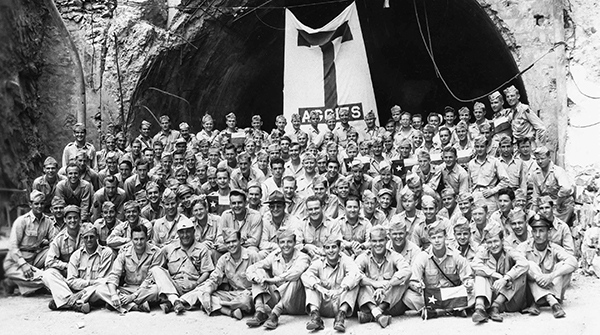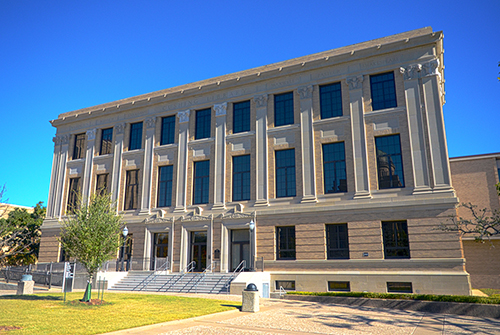This series explores Texas A&M history. In honor of this year’s Muster, we reflect on its longstanding tradition and ask university archivist Greg Bailey to share some artifacts from the event's history.
Each year on April 21, current and former students of Texas A&M University gather to celebrate Muster, one of the school’s most solemn and sacred traditions. Gatherings take place at more than 300 locations around the world, and each celebration is unique.
The 2017 campus Muster will be held in Reed Arena at 7:00 p.m. This year’s featured speaker is Dr. Ed “Eddie Joe” Davis ’67, former president of the Texas A&M Foundation. Davis, who celebrates his 50th class reunion this year, served as a Texas A&M Corps commander and is also a Vietnam War veteran.
Through the Roll Call for the Absent and the lighting of Muster candles, Aggies the world over signify that every student will be remembered. While every current and former student is familiar with the Muster tradition, not all may be as familiar with the tradition’s history.
 On April 21, 1946, over 100 Aggie soldiers returned to the island of Corregidor to stand at the mouth of the Malinta Tunnel and call the Muster for lives lost during the war. They used a table cloth as an improvised Aggie flag.
On April 21, 1946, over 100 Aggie soldiers returned to the island of Corregidor to stand at the mouth of the Malinta Tunnel and call the Muster for lives lost during the war. They used a table cloth as an improvised Aggie flag.
Blast from the Past
The year was 1942. World War II had the nation in a chokehold. In the fight against Japan, the small island of Corregidor in Manila Bay symbolized the last of America's strongholds in the Philippines.
As artillery shells from Japanese planes pummeled the island, the bombproof Malinta Tunnel proved the only safe spot for American soldiers. The long and narrow passageway, used as a headquarters, supply depot and makeshift hospital, became the spot of Aggie legend.
The famous account claims the Aggie soldiers held a roll call in the tunnel on April 21. Word was sent to news correspondents reporting from the island, and the reporters wired the story back to the United States. The broadcast told the story of a band of Aggies who came together to honor their fellow fallen soldiers. Despite whether this tale was entirely accurate, it encouraged a weary nation and solidified the tradition of Muster that remains today.
When World War II ended in 1945, the Filipinos were liberated from Japanese occupation. Over 100 Aggie soldiers returned once more to the island of Corregidor the following spring in 1946 to stand at the mouth of Malinta Tunnel and call the Muster for lives lost during the war. They used a table cloth as an improvised Aggie flag and hung it over the tunnel as they stood at attention singing “The Spirit of Aggieland.”
In 2015, a memorial was designed by Texas A&M architecture students and dedicated on the island of Corregidor to honor the Aggies who gathered there in 1942 and 1946 along with all Aggies who defended Corregidor and Bataan during World War II.
 Cushing Memorial Library and Archives
Cushing Memorial Library and Archives
Unearthing History
The Cushing Memorial Library and Archives, built in 1930, serves as home to the university’s special collections, rare books and archives. The library’s collection strengths include military history, science fiction, western Americana, natural history, Africana, Hispanic Studies, nautical archaeology, the history of the Texas A&M printing press and the history of Texas A&M.
In honor of this year’s Muster, we asked Greg Bailey, clinical assistant professor and university archivist, to share with us some of the most notable Muster artifacts in Cushing’s collections.
Tell us about some of the most unique Muster items in the archives.
The university’s collection includes the Corregidor Aggie flag from the 1946 Muster, black and white photographs from World War II-era Muster ceremonies; newspaper clippings; a letter dated 1945 detailing the 43rd Muster ceremony held in Florence, Italy; the program from the 1946 Campus Muster; and the program from a Muster held in North Korea in 1952.
Where did these items come from?
Most were donated by former students. Collections in the university archives are made up of not only official university documents, but also many items acquired by former students, faculty and staff.
What is the significance of the 1942 Corregidor Muster?
This Muster captured the nation’s imagination and boosted American pride and spirits. Even while under siege by the Japanese, the men still gathered and called muster. The following year was the first time the term “Aggie Muster” was used in reference to the April 21 gathering.
Why is it important to preserve Texas A&M artifacts?
By preserving Aggie artifacts and documents, Texas A&M’s history is being preserved. This allows future generations to understand, learn, value and research the history of our university.
How can someone support the preservation of artifacts, particularly Muster materials?
Individuals can always donate artifacts, photos, programs, speeches and flyers from past Musters. We would love to add items from around the world to document this important Aggie tradition. Some of these items need special care because of their fragility. To physically preserve items, we have a preservation and conservation department staffed by professionals who handle paper-based materials, but other items are sometimes sent to specialists who handle textiles or metals. All preservation efforts are expensive, so financial contributions are always appreciated.